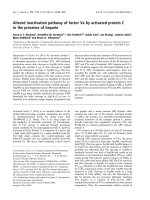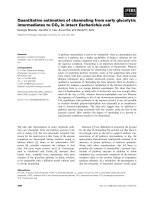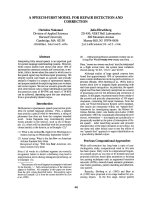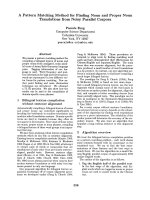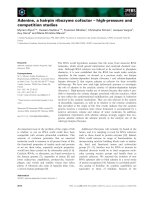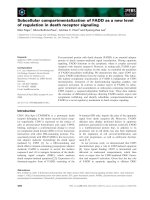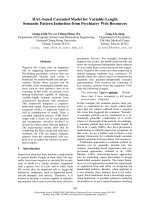báo cáo khoa học: " MoccaDB - an integrative database for functional, comparative and diversity studies in the Rubiaceae family" pdf
Bạn đang xem bản rút gọn của tài liệu. Xem và tải ngay bản đầy đủ của tài liệu tại đây (1.71 MB, 11 trang )
BioMed Central
Open Access
Page 1 of 11
(page number not for citation purposes)
BMC Plant Biology
Database
MoccaDB - an integrative database for functional,
comparative and diversity studies in the Rubiaceae family
Olga Plechakova
1
, Christine Tranchant-Dubreuil
1
, Fabrice Benedet
1,2
,
Marie Couderc
1
, Alexandra Tinaut
1
, Véronique Viader
1,3
, Petra De Block
4
,
Perla Hamon
1
, Claudine Campa
1
, Alexandre de Kochko
1
, Serge Hamon
1
and
Valérie Poncet*
1
Address:
1
UMR DIAPC, IRD, 911 avenue Agropolis, BP 64501, 34394 Montpellier Cedex 5, France,
2
CIRAD TA C 37/D, Campus International de
Baillarguet 34398 Montpellier Cedex 5, France,
3
UMR DIAPC, INRA, Domaine de MelgueiI, Chemin de Mézouls, 34130 Mauguio, France and
4
National Botanic Garden of Belgium, Domein van Bouchout, 1860 Meise, Belgium
Email: Olga Plechakova - ; Christine Tranchant-Dubreuil - ;
Fabrice Benedet - ; Marie Couderc - ; Alexandra Tinaut - ;
Véronique Viader - ; Petra De Block - ; Perla Hamon - ;
Claudine Campa - ; Alexandre de Kochko - ; Serge Hamon - ;
Valérie Poncet* -
* Corresponding author
Abstract
Background: In the past few years, functional genomics information has been rapidly accumulating
on Rubiaceae species and especially on those belonging to the Coffea genus (coffee trees). An
increasing number of expressed sequence tag (EST) data and EST- or genomic-derived
microsatellite markers have been generated, together with Conserved Ortholog Set (COS)
markers. This considerably facilitates comparative genomics or map-based genetic studies through
the common use of orthologous loci across different species. Similar genomic information is
available for e.g. tomato or potato, members of the Solanaceae family. Since both Rubiaceae and
Solanaceae belong to the Euasterids I (lamiids) integration of information on genetic markers would
be possible and lead to more efficient analyses and discovery of key loci involved in important traits
such as fruit development, quality, and maturation, or adaptation. Our goal was to develop a
comprehensive web data source for integrated information on validated orthologous markers in
Rubiaceae.
Description: MoccaDB is an online MySQL-PHP driven relational database that houses annotated
and/or mapped microsatellite markers in Rubiaceae. In its current release, the database stores 638
markers that have been defined on 259 ESTs and 379 genomic sequences. Marker information was
retrieved from 11 published works, and completed with original data on 132 microsatellite markers
validated in our laboratory. DNA sequences were derived from three Coffea species/hybrids.
Microsatellite markers were checked for similarity, in vitro tested for cross-amplification and
diversity/polymorphism status in up to 38 Rubiaceae species belonging to the Cinchonoideae and
Rubioideae subfamilies. Functional annotation was provided and some markers associated with
described metabolic pathways were also integrated. Users can search the database for marker,
sequence, map or diversity information through multi-option query forms. The retrieved data can
Published: 29 September 2009
BMC Plant Biology 2009, 9:123 doi:10.1186/1471-2229-9-123
Received: 23 April 2009
Accepted: 29 September 2009
This article is available from: />© 2009 Plechakova et al; licensee BioMed Central Ltd.
This is an Open Access article distributed under the terms of the Creative Commons Attribution License ( />),
which permits unrestricted use, distribution, and reproduction in any medium, provided the original work is properly cited.
BMC Plant Biology 2009, 9:123 />Page 2 of 11
(page number not for citation purposes)
be browsed and downloaded, along with protocols used, using a standard web browser. MoccaDB
also integrates bioinformatics tools (CMap viewer and local BLAST) and hyperlinks to related
external data sources (NCBI GenBank and PubMed, SOL Genomic Network database).
Conclusion: We believe that MoccaDB will be extremely useful for all researchers working in the
areas of comparative and functional genomics and molecular evolution, in general, and population
analysis and association mapping of Rubiaceae and Solanaceae species, in particular.
Background
Accumulation of available genetic markers directly con-
tributes to advances in marker-assisted genetic studies
with a wide range of applications such as detection and
identification of individual genes and/or quantitative trait
loci (QTL), or exploration of the genetic diversity and
population structure with regard to natural variations [1-
3]. The recent and rapid accumulation of sequence
resources, mainly from crop species, ensures an improve-
ment of the genetics approach in combination with the
comparative genomics. The extension of these genome
resources to their close relatives as well as to more distant
genera greatly facilitates the elucidation of evolutionary
histories. This elucidation involves the discovery and
study of key orthologous loci, phylogeny reconstruction
and a variety of other biological questions.
The Rubiaceae family is the fourth largest family of flow-
ering plants but, except for rare species such as Kadua cen-
tranthoides Hook. & Arn. [as Hedyotis centranthoides]and
Kadua affinis Cham. & Schltdl. [as Hedyotis terminalis]
(Levesque MP, Twigg RW, Motley T, Katari MS, Dedhia
NN, O'Shaughnessy AL, Balija V, Martienssen RA,
McCombie RW, Benfey P et al: Expressed tag sequences
from Hedyotis centranthoides and Hedyotis terminalis flow-
ers - Stage 2 (NYBG), accessions available from http://
www.ncbi.nlm.nih.gov 2003), most of the genomic infor-
mation has been generated from the major economic crop
species of the Coffea genus, cultivated throughout the
tropics: C. arabica L. and C. canephora Pierre ex A.Froeh-
ner, the Arabica and Robusta coffee trees, respectively.
They are thus used as molecular models for the Rubiaceae.
Integrative information of genomic and genetic knowl-
edge acquired for these plants can be further extended to
other Coffea species but also to other economically impor-
tant Rubiaceae genera used in medicine (e.g. Cinchona,
which produces quinine, is used as a cure for malaria),
and in horticulture (e.g. many genera, including Gardenia,
Ixora, Pentas, Mussaenda and Sherardia, are well known
ornamentals [4]).
Among PCR-amplified markers, microsatellite (or simple
sequence repeat, SSR) markers are commonly used in
large-scale genomic studies owing to their ubiquitous dis-
tribution in both protein-coding and non-coding regions
and the high degree of length polymorphism among indi-
viduals [5]. The C. canephora microsatellites were screened
in a leaf and fruit EST database [2] and in a C. canephora
BAC sequence [6]. The overall SSR density has been esti-
mated as one SSR every 7.73 kb and one SSR every 4.1 kb,
in the ESTs and in the genomic sequences, respectively
[2,6]. However, although microsatellites are distributed
ubiquitously throughout the Coffea genome, only a few of
them are suitable for designing informative markers with
properties such as strong and specific amplified fragment
after PCR and easy scoring of allele sizes, high heterozy-
gosity and/or known position along a linkage map.
Functional genomics is particularly promising for identi-
fying genes involved in a variety of biological functions,
which include pathways related to the coffee beverage
quality such as synthesis of caffeine, sugars, lipids and
chlorogenic acids, but also those related to fruit develop-
ment. The use of markers directly targeting expressed
genes important for each specific trait would be beneficial
to these studies. Due to the ongoing sequencing of
expressed genes from different plant organs, it is now pos-
sible to develop EST-SSR markers for important traits, like
fruit properties.
Previous publications [1,2,7,8] and the present study have
revealed that coffee EST-SSR and SSR markers show a high
level of transferability across distantly related species,
thereby providing additional markers for orphan
Rubiaceae species.
Although the genomic data available on coffee plants are
rapidly increasing, they are often isolated and scattered
and rarely available online. In the present study, an effort
has been made to create a centralized access to both pub-
lished and original new data on evolutionarily conserved
and validated markers. Integrated comprehensive infor-
mation system and bioinformatics tools are provided,
which will be useful for the research community working
on plant genetics and evolution of coffee tree related
organisms.
Construction and content
Data source
The data retrieval and compilation for MoccaDB has
involved the following steps: (1) extraction of data from
various sources (publications, public databases etc.); (2)
BMC Plant Biology 2009, 9:123 />Page 3 of 11
(page number not for citation purposes)
development and testing of additional new markers in
Rubiaceae species; (3) compilation, elimination of
marker redundancy, BLAST annotation; (4) insertion into
the database.
Marker and sequence source
The current version of MoccaDB provides information
regarding Coffea EST and genomic SSR markers retrieved
from 11 published studies as well as original data (table
1). The database stores 638 markers, defined on 259 ESTs
and 379 genomic sequences.
Complete information on the origin of the data was
reported such as laboratory, DNA library description, and,
finally, reference of the published work. Polymerase chain
reaction (PCR) primers, amplification conditions, and
expected product sizes were directly retrieved from the
publications, when available.
For most of the markers, nucleotide sequences were
downloaded from GenBank databases http://
www.ncbi.nlm.nih.gov and stored in the database.
A unique set of markers
Most of the retrieved markers had been declared by their
authors as designed on unigenes or, at least, on non-
redundant DNA sequences. Nevertheless, to identify any
redundancy due to the multiple origin of the data, all
DNA sequences were checked for homology using the
DNASTAR software package (Lasergene, Madison, WI,
USA). The markers designed on sequences having a simi-
larity percentage >90% were defined as "similar markers"
in the database.
Annotation
Markers stored in the database are provided with a general
SSR description: repeat motif and number, corresponding
amino acid repeat if any, and, if known, SSR position on
the sequence (coding region or UTR, as described in [2]).
Markers associated with experimentally described meta-
bolic pathways (e.g. sucrose metabolism during coffee
fruit development [9]) were integrated. Putative functions
were predicted for all DNA sequences through similarity
searches using BLASTx against GenBank protein databases
[10].
Maps, transferability and diversity
Marker mapping data were retrieved from a published
inter-specific Coffea linkage map [11] and can be visual-
ized with CMap [12], integrated in MoccaDB.
The high transferability of SSR markers at evolutionarily
conserved (orthologous) loci within the Coffea genus has
been previously reported by different authors. For exam-
ple, the percentage of transferability of SSR markers devel-
oped on C. arabica genomic DNA ranged from 72.7% for
C. liberica Hiern to 86.4% for C. pseudozanguebariae Brid-
son [13].
Table 1: Microsatellite markers, Sequence sources and original data
Marker acronym used
by the authors
Sequence type Sequence origin
(Coffea)
No of markers Reference Taxa tested
CofEST-SSR EST C. canephora × C.
congensis
9 (Bhat et al., 2005) [24] 11 Coffea sp.
4 Psilanthus sp.
ES EST C. canephora 99 (Poncet et al., 2006) [2] 7 Coffea sp.
Present study 21 Rubiaceae sp.
SSR EST C. canephora 10 (Geromel et al., 2006) [9] C. arabica
DCM/CofEST-SSR EST C. sp. 9 (Aggarwal et al., 2007) [7] 11 Coffea sp.
4 Psilanthus sp.
Ssr EST C. canephora 132
(Crouzillat et al.,
unpublished data)
Present study 3 Coffea sp.
M Genomic C. arabica 10 (Combes et al., 2000) [25]
M Genomic C. arabica 17 (Coulibaly et al., 2003) [11] 2 Coffea sp.
CM Genomic C. arabica 9 (Baruah et al., 2003) [26] 11 Coffea sp.
4 Psilanthus sp.
CFGA Genomic C. arabica 34 (Moncada et al., 2004) [27] C. arabica
M Genomic C. arabica 77 (Poncet et al., 2004) [13] 6 Coffea sp.
DL Genomic C. canephora 8 (Leroy et al., 2005) [19] C. canephora
M Genomic C. canephora 213 (Poncet et al., 2007) [1] 3 Coffea sp.
Genomic C. arabica 9
(Lashermes et al.,
unpublished data)
Total 638
BMC Plant Biology 2009, 9:123 />Page 4 of 11
(page number not for citation purposes)
Our previously published [2] and newly designed EST-SSR
markers (Table 1), at a total of 99, were tested for amplifi-
cation on a panel consisting of up to 21 Rubiaceae species
belonging to the Cinchonoideae and Rubioideae sub-
families [14](Table 1). A new set of EST-SSR markers, pro-
vided by Crouzillat et al. (Table 1), was also tested on the
following Coffea species: C. canephora, C. heterocalyx Stoff.,
and C. pseudozanguebariae. Only those showing a good
and specific PCR amplification with an easy scoring of
allele sizes were retained.
Both for markers retrieved from publications and for
those designed and/or tested in this study, a maximum of
available transferability-associated information was
stored in the database: transferability status, amplification
quality, information on the polymorphism (number and
sizes of alleles within a given species, polymorphism
information content (PIC) value).
Database and Web application
MoccaDB has been designed for simple and efficient
information search and retrieval. It is currently housed on
a Linux Red Hat Enterprise server but is generally plat-
form-independent. The database design has been carried
out using the Unified Modeling Language (UML). Moc-
caDB is composed of two major components: a relational
database created using open-access MySQL 5.0 and a PHP
web application that communicates with the database.
The web interface runs on the Apache 2 Web server. The
PHP scripts dynamically execute complex SQL queries to
retrieve data from the database according to user criteria
and display them as a standard HTML output using CSS
style sheets. MoccaDB also integrates bioinformatics tools
such as BLAST [10] and CMap [12]. For an overview of the
MoccaDB structure and interaction with the bioinformat-
ics tools and external data sources, see Fig. 1.
The database contains mainly public but also some pri-
vate data. The public data are accessible to any person
connected to the MoccaDB Web site. To access to the pri-
vate data of some scientific projects as well as to insert
one's own data (markers, DNA sequences or mapping
data) in the database, the user should open an account
that is created with the permission of the scientific project
Overview of the MoccaDB applicationFigure 1
Overview of the MoccaDB application. MoccaDB integrates different data types, which are interconnected and linked to
external resources and bioinformatic tools (CMap and BLAST).
BMC Plant Biology 2009, 9:123 />Page 5 of 11
(page number not for citation purposes)
manager. Several supplementary Web interfaces have thus
been developed allowing the user an administrative access
and database feeding.
Utility
A user-friendly web interface has been developed to facil-
itate data retrieval according to specific user needs. One
can search for markers, DNA sequences, maps and diver-
sity data by using the corresponding multi-option query
forms. The data can be viewed with a different degree of
details, either as an overview (a list of search results), or as
a detailed result page for a selected marker, sequence or
map, with information on marker transferability, diversity
and mapping. The experimental conditions, sequences
and other relevant data are easily downloadable in differ-
ent formats. Some additional information, like the con-
struction of DNA libraries or description of the marker
types, can be visualized with the help of pop up windows.
Extensive, mostly bi-directional, hyperlinks are provided
between the different data pages, thus facilitating the nav-
igation within the web site (Fig. 1).
Synthetic and downloadable information on annotated
markers
Through the marker search page, markers can be directly
searched by their names but the query can also be filtered
by marker type, species and sequence origin, as well as by
the availability of experimental data on their transferabil-
ity and mapping.
The search results are displayed in the form of a table pro-
viding general information on each marker. The users can
select any number of markers from this table and down-
load them as an Excel file, together with additional
optional information such as PCR experimental condi-
tions, original DNA sequence, diversity/transferability or
mapping data, depending on their scientific interests and
future data utilisation. They can also access the detailed
individual marker pages via the hyperlinks associated with
each marker.
A typical individual marker page (Fig. 2) displays detailed
information on diverse marker aspects: original sequence
Screenshots of a MoccaDB marker data pagesFigure 2
Screenshots of a MoccaDB marker data pages. (A) Marker detail page resulting from searching for the M257 marker.
The result page provides general information about the SSR marker (e.g. repeat motif, repeat number) as well as the corre-
sponding genomic sequence with database cross-references to NCBI and SOL (if available) and a hyperlink to the MoccaDB
Sequence detail Page (B). The mapping information section provides information about marker locations on the genetic map,
which links to the CMap viewer (C) and the CMap feature detail popup (D). The PCR information section may also provide
details on marker assay conditions (forward and reverse primers, melting temperatures, predicted size of PCR product). The
reference section gives publications related to this marker with links to Pubmed.
BMC Plant Biology 2009, 9:123 />Page 6 of 11
(page number not for citation purposes)
Screenshots of sequence/putative function MoccaDB result pagesFigure 3
Screenshots of sequence/putative function MoccaDB result pages. Sequences can be searched by name, putative
annotation. The search can be restricted using different criteria such as sequence origin or marker type. The group of screen-
shots shows an example sequence search using the keyword 'transferase' to find out what sequences have been "putatively"
annotated with this term. (A) The result page displays sequences and related data resulting from searching for the annotation
term 'transferase'. The tabular text summary lists all the sequences found, each line in the table presenting the sequence name
and related information (sequence type and origin, marker name and BLAST annotation). The marker name and sequence
name are respectively linked to the marker detail page (C) and to the sequence detail page (B). The user can select sequences
and export them in FASTA format. The sequence detail page (B) displays all the associated information for that sequence which
includes general information (e.g.: sequence type, DNA bank), annotation information, marker information and publications
related to that sequence. Hyperlinks give access to associated data within MOCCAdb such as markers, DNA bank or link to
external resources such as SOL or NCBI.
BMC Plant Biology 2009, 9:123 />Page 7 of 11
(page number not for citation purposes)
information, map location, transferability and/or intra-
and inter-diversity, existence of "similar" markers devel-
oped on the same locus by other researchers, etc
The genetically mapped markers can also be searched
through the map search page. For each map, linkage
groups can be displayed separately or together thanks to
the CMap tool. A link associated with each SSR marker on
the map brings the user back to the marker data page (Fig.
2).
Functional markers directly targeting the expressed genes
A user can search for sequences used to design the markers
through the sequence search page. The query will option-
ally take into account the sequence name, species origin,
sequence or marker type, and, more specifically, its puta-
tive function, namely a keyword in the BLAST annotation
(e.g. transferase, Fig. 3). The sequence search page is espe-
cially useful when searching for "functional" markers
linked to a particular metabolic pathway. Among different
functions, the database is hosting markers associated with
the sucrose metabolism [9].
The resulting searched sequences are displayed in a sum-
mary table with hyperlinks that give further access to
sequence or marker data pages (Fig. 3). From this table,
sequences selected by the user can be downloaded in a
multi-fasta file to facilitate subsequent external analyses
(BLAST search, clustering, etc ).
These functional markers could also be used in such stud-
ies as functional mapping, population analyses or associ-
ation mapping.
Transferable markers and polymorphism status
Transfer of genomic tools across species boundaries is cru-
cial to assess variation in relevant germplasm and consti-
tutes a unique tool to study orphan related species.
In its current release, MoccaDB already gives access to val-
uable transferability data. In particular, of the C. canephora
and C. arabica markers screened for cross-amplification
and polymorphism, a minimum of 83% amplified alleles
from any wild Coffea species, independently of its genetic
relationship to both cultivated species (Fig. 4). Across the
Rubiaceae family, many coffee markers were transferable
to wild relatives of the Cinchonoideae subfamily, but only
a fraction, maximum 12%, was transferable to distantly
related genera in the Rubioideae subfamily (Table 2).
When working on one or more given species, the biologist
can thus use the diversity query page to search markers
that amplify these species, and eventually reveal inter-spe-
cific polymorphism (such as species-specific alleles) or
intra-specific polymorphism (through the PIC parame-
ter). Results for the searched markers are displayed in the
form of a summary table (Fig. 5) with details on the
marker transferability: species tested, amplification status,
polymorphism, amplified allele range. These data will be
particularly useful for researchers looking for an optimal
polymorphic marker set for genotyping populations of a
given species.
If the objective is the selection of markers for refining
mapping in an inter-specific cross, or for discriminating
two or more species, the user can identify diagnostic
markers (i.e. with species-specific allele range) with
known genetic map location or not.
A synthetic results table of these data can be obtained and
downloaded from the marker search query page (Fig. 5).
Bioinformatics tools and external links
CMap and the NCBI BLAST2.0 [10] were integrated into
MoccaDB. Any given sequence can be searched for simi-
larities against the MoccaDB sequences or updated public
GenBank Coffea databases: (1) all C. arabica and/or C.
Table 2: Transferability to Rubiaceae species: efficiency of cross amplification of Coffea markers in other Rubiaceae genus (Nb species
tested when over 1).
Genus % amplification Nb of tested markers Genus % amplification Nb of tested markers
Cinchonoideae Paracephaelis 32% 25 C
Coffea (14 sp.) 94% Up to 207 C, up to 49 A Genipa 24% 25 C
Psilanthus (4 sp.) 82% 9 A Chiococca 16% 25 C
Tricalysia (2 sp.) 68% 25 C Ixora 16% 25 C
Bertiera 56% 25 C Uncaria 4% 25 C
Pavetta 48% 25 C Rubioideae
Coptosperma 40% 25 C Oldenlandia (2 sp.) 12% 25 C
Leptactina 36% 25 C Psychotria (4 sp.) 10% 25 C
Tarenna 36% 25 C Spermacoce (2 sp.) 6% 25 C
Markers were developed on C. canephora (C) or C. arabica (A) sequences.
BMC Plant Biology 2009, 9:123 />Page 8 of 11
(page number not for citation purposes)
canephora sequences; (2) C. arabica and/or C. canephora
EST sequences; (3) C. arabica and/or C. canephora Genome
Survey Sequences (GSS) sequences; (4) C. arabica and/or
C. canephora «CoreNucleotide» (EST and GSS sequences
not included).
External links connect MoccaDB to the NCBI genbank and
Pubmed data, and to the SOL Genomics Network data-
base [15] for some of the sequences developed on C.
canephora by Crouzillat et al. (see table 1).
Conclusion and perspectives
Contrary to some currently existing plant marker data-
bases that contain predicted molecular markers (e.g.
[16]), MoccaDB only stores validated markers provided
with experimental protocols and related data. Indeed, we
intended to centralize information on markers associated
with single-copy loci, which can be reproducibly used for
genetic analysis within the Coffea genus and related spe-
cies.
Some Coffea genetic markers were made available by very
few open and freely accessible database resources (Trieste
[17], CIRAD [18]), but these resources are mostly limited
to SSR data generated by their own hosting institute.
MoccaDB includes most of the publicly available data in
addition to original data. As compared to the previously
released databases, MoccaDB provides greater integrated
information and specific features:
(1) Multiple options for data search and retrieval;
Schematic phylogenetic tree adapted from [21] and number of successfully amplified/tested markers (percentage) observed for each speciesFigure 4
Schematic phylogenetic tree adapted from [21]and number of successfully amplified/tested markers (percent-
age) observed for each species. The information was extracted from MoccaDB database. Names of Coffea species follow
[22,23].
BMC Plant Biology 2009, 9:123 />Page 9 of 11
(page number not for citation purposes)
(2) Complete description of the markers, going from
in vitro PCR amplification conditions, SSR and func-
tional annotation of original DNA sequences and
marker location on genetic maps, to cross amplifica-
tion and diversity data;
(3) Synthetic and downloadable cross-amplification
and diversity spreadsheet results to help the user in
designing an optimal set of orthologous markers for
genotypying or mapping studies in selected species
and populations;
(4) Data selected by the user can be easily downloaded
and used in laboratory experiments (PCR conditions,
expected sizes, etc ) or for further analysis such as
BLAST similarity searches of SSR-associated sequences
(sequences provided in fasta format, etc );
Screenshots of transferability/diversity MoccaDB result pagesFigure 5
Screenshots of transferability/diversity MoccaDB result pages. (A) Marker search gives access to a synthetic results
table with basic transferability data. Users can select markers and export related data on the amplified species and the corre-
sponding allele size ranges (in bp) as Excel files. Hyperlinks on this result page gives access to the marker detail page (B), where
this information can be directly visualized for each specific marker. Using the hyperlinks "more details", users can access addi-
tional details (C) on the transferability efficiency (presence or not of amplification products, quality of the amplification) and on
the polymorphism status (number and sizes of the alleles, PIC values for each study). These diversity data can also be retrieved
through the diversity search page and query filtered according to the species studied.
BMC Plant Biology 2009, 9:123 />Page 10 of 11
(page number not for citation purposes)
(5) Access is provided to integrated bioinformatics
tools (CMap, BLAST), as well as to external hyperlinks
to various public data sources (NCBI GenBank and
Pubmed, SOL Genomics Network [15])
MoccaDB evolution
In MoccaDB, a large amount of information is centralized
and freely accessible to all users. A login system exists only
for private project access and for data submission. To facil-
itate data integration, comma-separated values (csv) sub-
mission forms have been defined to allow automatical
submission of data. More markers will be included in the
database as and when they are made publicly available.
The database currently houses SSR markers from both
genic and non-genic regions of the genome. Markers
whose polymorphism is due to single-nucleotide poly-
morphism (SNPs), insertion/deletion (indels) or trans-
posable elements are in the process of being developed
and will be stored in MoccaDB in a near future.
Coffee has increasingly rich genetic and genomic
resources including expressed sequences tags (ESTs) [e.g.
[2]] and bacterial artificial chromosome (BAC) libraries
[6,19]. Whole genome sequencing, genetic, physical and
comparative maps are being developed. MoccaDB will be
extended to include new data types, but also links to cyto-
logical maps and morphological data.
Systematic efforts have been initiated to generate PCR-
based comparative genetic maps in several clades of
plants, particularly in Solanaceae using Conserved
Ortholog Set (COS) markers [20]. Data obtained in this
family could be of benefit for wide comparative genomics
studies including those of Rubiaceae species.
Availability and requirements
The database is open and freely available
Project name: MoccaDB
Project home page: />Operating system: Linux but functions also on Windows
Programming language: PHP5 (PHP4 compatible),
(X)HTML, CSS2, JavaScript, AJAX, MySQL 5.0.45, SQL92
Other requirements: none
License: None required
Competing interests
The authors declare that they have no competing interests.
Authors' contributions
OP designed the project, designed and implemented the
database, developed the web interfaces, FB designed the
web interface. MC, AT and VV helped in analyzing the
published markers, carried out the PCR amplification
experiments and the genotyping. PDB identified/supplied
plant material of Rubiaceae species from the greenhouses
of the National Botanic Garden of Belgium. PDB and PH
helped with the cross-amplification experiments and
diversity analyses. CC helped in designing the database.
AdK secured partial funding from the IRD-SPIRALES
Board. AdK and SH coordinated the project. CT managed
the project development, assisted in the designing of the
database, performed database system administration,
integrated the bioinformatics tools in the application. VP
served as the principal investigator of the project, per-
formed the data analysis, assisted in the designing of the
database, and drafted the manuscript. All authors have
contributed in the writing of the manuscript and have
read and approved the final submitted version.
Acknowledgements
We gratefully acknowledge the financial support from the IRD-SPIRALES-
2007 grant funding. The authors thank D. Crouzillat of Nestlé for permit-
ting the integration of Nestlé's primer data into MoccaDB and Y. Pournin
and A. Egorov (system administrators) for technical support. The authors
also thank D. Pot for valuable comments on the initial project and L. Muel-
ler and R. Guyot for their advice on the manuscript.
References
1. Poncet V, Dufour M, Hamon P, Hamon S, de Kochko A, Leroy T:
Development of genomic microsatellite markers in Coffea
canephora and their transferability to other coffee species.
Genome 2007, 50(12):1156-1161.
2. Poncet V, Rondeau M, Tranchant C, Cayrel A, Hamon S, de Kochko
A, Hamon P: SSR mining in coffee tree EST databases: poten-
tial use of EST-SSRs as markers for the Coffea genus. Mol
Genet Genomics 2006, 276(5):436-449.
3. Varshney RK, Graner A, Sorrells ME: Genic microsatellite mark-
ers in plants: features and applications. Trends Biotechnol 2005,
23(1):48-55.
4. Davis A, Bridson D: Rubiaceae. In Flowering Plant Families of the
World Edited by: Heywood V, Brummitt R, Culham A. Seberg O: RBG
Kew; 2007.
5. Sharma PC, Grover A, Kahl G: Mining microsatellites in eukary-
otic genomes. Trends in Biotechnology 2007, 25(11):490-498.
6. Guyot R, de la Mare M, Viader V, Hamon P, Coriton O, Bustamante-
Porras J, Poncet V, Campa C, Hamon S, de Kochko A: Microcolline-
arity in an ethylene receptor coding gene region of the Cof-
fea canephora genome is extensively conserved with Vitis
vinifera and other distant dicotyledonous sequenced
genomes. BMC Plant Biol 2009, 9(1):22.
7. Aggarwal RK, Hendre PS, Varshney RK, Bhat PR, Krishnakumar V,
Singh L: Identification, characterization and utilization of
EST-derived genic microsatellite markers for genome anal-
yses of coffee and related species. Theor Appl Genet 2007,
114(2):359-372.
8. Cubry P, Musoli P, Legnate H, Pot D, de Bellis F, Poncet V, Anthony
F, Dufour M, Leroy T: Diversity in coffee using SSR markers:
structure of the Coffea genus and perspectives for breeding.
Genome 2008, 51(1):50-63.
9. Geromel C, Ferreira LP, Guerreiro SM, Cavalari AA, Pot D, Pereira
LF, Leroy T, Vieira LG, Mazzafera P, Marraccini P: Biochemical and
genomic analysis of sucrose metabolism during coffee (Cof-
fea arabica) fruit development. J Exp Bot 2006,
57(12):3243-3258.
Publish with BioMed Central and every
scientist can read your work free of charge
"BioMed Central will be the most significant development for
disseminating the results of biomedical researc h in our lifetime."
Sir Paul Nurse, Cancer Research UK
Your research papers will be:
available free of charge to the entire biomedical community
peer reviewed and published immediately upon acceptance
cited in PubMed and archived on PubMed Central
yours — you keep the copyright
Submit your manuscript here:
/>BioMedcentral
BMC Plant Biology 2009, 9:123 />Page 11 of 11
(page number not for citation purposes)
10. Altschul SF, Madden TL, Schaffer AA, Zhang J, Zhang Z, Miller W, Lip-
man DJ: Gapped BLAST and PSI-BLAST: a new generation of
protein database search programs. Nucleic Acids Res 1997,
25(17):3389-3402.
11. Coulibaly I, Revol B, Noirot M, Poncet V, Lorieux M, Carasco-
Lacombe C, Minier J, Dufour M, Hamon P: AFLP and SSR poly-
morphism in a Coffea interspecific backcross progeny [(C.
canephora × C. heterocalyx) × C. canephora]. Theor Appl Genet
2003, 107(6):1148-1155.
12. Martin NH, Willis JH: Ecological divergence associated with
mating system causes nearly complete reproductive isola-
tion between sympatric Mimulus species. Evolution 2007,
61(1):68-82.
13. Poncet V, Hamon P, Minier J, Carasco-Lacombe C, Hamon S, Noirot
M: SSR cross-amplification and variation within coffee trees
(Coffea spp.). Genome 2004, 47(6):1071-1081.
14. Robbrecht E, Manen J-F: The major evolutionary lineages of the
coffee family (Rubiaceae, angiosperms). Syst Geogr Pl
2006:85-146.
15. Mueller LA, Solow TH, Taylor N, Skwarecki B, Buels R, Binns J, Lin C,
Wright MH, Ahrens R, Wang Y, et al.: The SOL Genomics Net-
work. A Comparative Resource for Solanaceae Biology and
Beyond. Plant Physiol 2005, 138(3):1310-1317.
16. Rudd S, Schoof H, Mayer K: PlantMarkers a database of pre-
dicted molecular markers from plants. Nucleic Acids Res
2005:D628-632.
17. Coffee DNA [ />]
18. Ruiz M, Rouard M, Raboin LM, Lartaud M, Lagoda P, Courtois B:
TropGENE-DB, a multi-tropical crop information system.
Nucleic Acids Res 2004:D364-367.
19. Leroy T, Marraccini P, Dufour M, Montagnon C, Lashermes P, Sabau
X, Ferreira LP, Jourdan I, Pot D, Andrade AC, et al.: Construction
and characterization of a Coffea canephora BAC library to
study the organization of sucrose biosynthesis genes. Theor
Appl Genet 2005, 111(6):1032-1041.
20. Wu F, Mueller LA, Crouzillat D, Petiard V, Tanksley SD: Combining
bioinformatics and phylogenetics to identify large sets of sin-
gle-copy orthologous genes (COSII) for comparative, evolu-
tionary and systematic studies: a test case in the euasterid
plant clade. Genetics 2006, 174(3):1407-1420.
21. Lashermes P, Combes MC, Trouslot P, Charrier A: Phylogenetic
relationships of coffee-tree species (Coffea L.) as inferred
from ITS sequences of nuclear ribosomal DNA. Theor Appl
Genet 1997, 94(6-7):947-955.
22. Stoffelen P, Noirot M, Couturon E, Bontems S, De Block P, Anthony
F: Coffea anthonyi, a new self-compatible Central African
coffee species, closely related to an ancestor of Coffea ara-
bica. Taxon 2009, 58(1):133-140.
23. Davis AP, Govaerts R, Bridson DM, Stoffelen P: An annotated tax-
onomic conspectus of the genus Coffea (Rubiaceae). Botanical
Journal of the Linnean Society 2006, 152(4):465-512.
24. Bhat PR, Krishnakumar V, Hendre PS, Rajendrakumar P, Varshney RK,
Aggarwal RK: Identification and characterization of expressed
sequence tags-derived simple sequence repeats, markers
from robusta coffee variety 'CxR' (an interspecific hybrid of
Coffea canephora × Coffea congensis). Molecular Ecology Notes
2005, 5(1):80-83.
25. Combes MC, Andrzejewski S, Anthony F, Bertrand B, Rovelli P, Grazi-
osi G, Lashermes P: Characterization of microsatellite loci in
Coffea arabica and related coffee species. Mol Ecol 2000,
9(8):1178-1180.
26. Baruah A, Naik P, Hendre S, Rajkumar R, Rajendrakumar P, Aggarwal
RK: Isolation and characterization of nine microsatellite
markers from Coffea arabica L., showing wide cross-species
amplifications. Molecular Ecology Notes 2003, 3(4):647-650.
27. Moncada P, McCouch S: Simple sequence repeat diversity in
diploid and tetraploid Coffea species. Genome 2004,
47(3):501-509.

